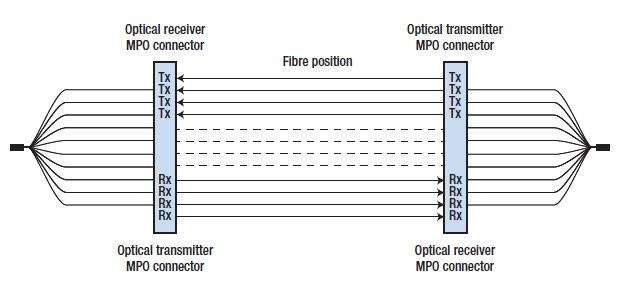How to avoid design overkill

Innovation cycles for both systems and networks have become shorter than ever before. That’s why advanced infrastructure solutions like parallel optical connectivity technologies, which support data rates above those that are currently needed, are by no means ‘design overkill’.
Quite the contrary – with them, system designers can avoid bottleneck effects and expensive rework in backbones or in other areas with high data aggregation. In following the principle of protecting investments, the backbone (permanent link) for today’s 10GBE systems should also meet the requirements of future parallel optical links.
ADVERTISEMENT
New Standard
In June 2010, following the introduction of IEEE 802.3ae for 10GBE, there came a new standard for 40/100Gbps Ethernet, specifically IEEE 802.3ba.
A primary motivation for the development of a new Standard was the increase in requirements on high speed data transfer in data centres. As part of IEEE 802.3ba, a number of versions were defined for 40/100GBE connections.
Because the vast majority of link distances in data centres are shorter than 15m, 40GBASE-SRT4 and 100GBASE-SR10 (short range over multi-mode optical fibre) are the versions most frequently put to use. Both concern parallel optical transmission over four or 10 fibres, in other words 4 x 10Gbps or 10 x 10Gbps. For 40GBASE-SR4, eight optical fibres of category OM3 or OM4 are required per link, and for 100GBASE-SR10, 20 such fibres are required per link.
New connector
The great expansion in the number of optical fibres in parallel optical transmissions also has an impact on connector technology. Compared to 10GBE, four or even 10 times as many connectors must be integrated into ports. Conventional connectors would take up too much space, and the demand for higher densities in the infrastructure while at the same time achieving the highest levels of reliability also stand in the way.
For this reason, the MPO multi-fibre connector was adopted in the 802.3ba standard for 40GBASE-SR4 and 100GBASESR10. The acronym MPO stands for multi-fibre push on and also multipath push on. In the smallest amount of space – equivalent to the size of an RJ45 connector – MPO connectors can theoretically connect as many as 72 fibres. In practice, connectors with 12 or 35 fibres are common. For 40GBASE-SR4, a type of MPO connector with 12 fibre positions is generally used, and for 100GBASESR10, a type with 24 fibre positions is used (in each case, four positions remain free because only eight or 20 fibres are required for the transmission).
New requirements
Parallel optical connections place increased demands on the optical and mechanical properties of connectors. MPO technology and in particular the optimised MTP (mechanical transfer push-on) connectors from the manufacturer US Conec have proven to be an excellent solution.
For parallel optical connectivity technology, R&M relies on MTP connectors with high-quality MT Elite ferrules, and the company has further improved these components’ already good technical optical performance with a finishing process it has developed on its own. In this way, ferrule tolerances as specified according to IEC have not only been tightened, but beyond that new parameters have been defined.
MPO/MTP connectors are offered in combination with correspondingly high quality optical cables (OM3 or OM4) as factory preassembled and tested patch and trunk cables. The result is a first-class multi-fibre connectivity solution that makes the assembly and operation or parallel optical 40/100Gbps links as easy and risk free as single fibre connections.
-
ADVERTISEMENT
-
ADVERTISEMENT

